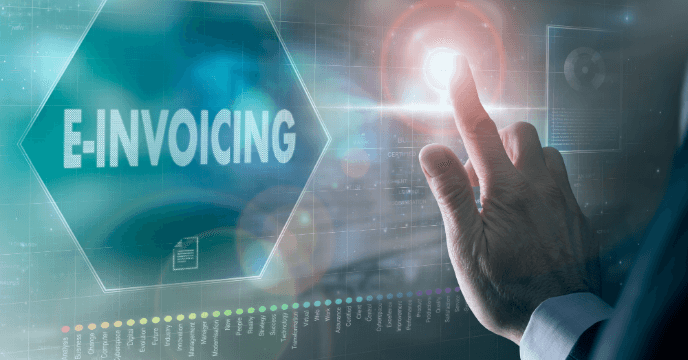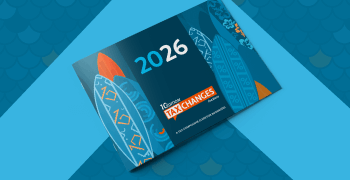
E-invoicing is coming, and it could be great for your accounting practice
It’s an exciting time to be in accounting. With technology streamlining many routine tasks, accounting professionals can devote more time to advising clients and expanding their practice. For a growing number of accounting businesses, e-invoicing could be the next frontier.
“U.S. businesses are linked through a global web of interconnected supply chains,” notes the U.S. Chamber of Commerce. And global business is no longer the purview of multinational corporations alone. Per the International Trade Administration, 97% of the 288,000 American companies that exported in 2019 were small and midsize businesses.
Due to the rise of e-invoicing mandates, many companies doing business outside of the U.S. will eventually need to be able to accept, produce, and/or transmit electronic invoices.
E-invoicing and live reporting mandates are already in effect in some parts of the world. All suppliers are required to issue electronic invoices in Brazil, for instance, and all buyers are required to receive them. Suppliers cannot ship goods to customers without first submitting an e-invoice to the tax authorities, so companies unable to generate, receive, or share electronic invoices in the required formats cannot do business in Brazil.
As a trusted accounting partner and advisor, your clients will look to you to help them understand and comply with the world’s complex and varied electronic invoicing landscape.
If you haven’t yet had time to get your head round e-invoices, you’re not alone. After all, there are no e-invoicing mandates in the United States at this time. But given the global nature of business today, it’s going to get harder for U.S.-based businesses to avoid e-invoicing. The sooner you develop expertise in this area, the more valuable you’ll be to your clients.
Read on to deepen your understanding of e-invoicing.
What is an e-invoice?
An e-invoice contains the same information as a paper or PDF invoice, but in a structured digital format that can be read by machines.
Broadly speaking, there are two types of e-invoices:
- E-invoices in a pure structured format for electronic data interchange (EDI) that’s machine readable but cannot be read by humans
- E-invoices in a hybrid format that contain machine-readable structured data for EDI and provide a visual PDF-format readable by humans
Different countries use different formats and may require different e-invoices for different types of transactions. In Brazil, for example:
- A Nota Fiscal Eletrônica (NF-e) documents the sale of goods
- A Nota Fiscal de Serviços Eletrônica (NFS-e) documents the provision of services
- A Conhecimento de Transporte Eletrônico (CT-e) documents the transportation of goods by air, pipeline, rail, road, or water
Read What is electronic invoicing (e-invoicing)? and What US sellers need to know about e-invoicing for more details.
How are e-invoices sent?
E-invoices are created, transmitted, and received electronically, using a structured data format. Depending on country specifics, there are several ways to transmit electronic invoices:
- Via a document exchange network like DBNA or Peppol
- Via a centralized government portal
- Via a private peer-to-peer EDI connection
While private peer-to-peer EDI connections require the buyer and the seller to agree on the formats and transmission protocols used, Peppol, DBNA, and centralized government platforms offer standardized formats and transmission protocols for the e-invoice exchange. A service provider like Avalara can help companies connect their finance operations to those networks and portals and start benefiting from their usage.
Sending an e-invoice isn’t like stuffing a paper invoice into an envelope, sticking it in the mail, and trusting it will land on the right desk. The recipient, whether a government agency, business, or consumer, must be set up to receive the e-invoice. With e-invoicing, it’s essential to be aware of system requirements and communicate with clients early and often.
Which countries have e-invoicing mandates?
An “e-invoicing mandate” refers to an obligation for a business to use e-invoicing in its billing process. It also makes using other types of invoicing, like paper or PDF invoices, noncompliant. More than 80 countries either have e-invoicing mandates now or have announced upcoming mandates.
Most countries are phasing in electronic invoicing, often starting with e-invoices for business-to-government (B2G) transactions, like countries in the European Union, then extending to business-to-business (B2B) transactions. This is the case in Romania, where the B2G mandate was recently extended to B2B. Many countries even demand business-to-consumer (B2C) sales to follow established mandates — like in Italy, where B2C invoices must first be submitted to the government’s SdI portal.
In many countries, like Singapore, Australia, or New Zealand, use of e-invoicing is not mandated by the government but is strongly recommended and supported via different programs by the government. Countries that plan to introduce a mandate in the future, like Poland, often offer voluntary-participation pilot programs to encourage companies to prepare in advance.
The timeline for e-invoicing mandates is constantly evolving. For instance, France initially planned to phase in mandatory e-invoicing starting July 1, 2024, but in December 2023, it published a new timetable. This new date can also change.
When is the right time to introduce e-invoicing to your clients?
If your clients do business in a country that has or is developing an e-invoicing mandate, they’ll need to be able to create, transmit, and receive electronic invoices as required.
For many countries, e-invoicing is a question of when, not if. In other words, while your clients may not be obligated to comply with an e-invoicing mandate today, they’ll likely have to send or receive e-invoices eventually.
Let’s look at what’s happening in France as an example. Under the current timeline, large businesses must be able to both send and receive electronic invoices starting September 1, 2026. Small and midsize companies must also be able to receive e-invoices starting September 1, 2026, but they won’t be obligated to send them until September 1, 2027.
Similar changes are planned in Belgium. Effective January 1, 2026, Belgium will require e-invoicing for domestic B2B transactions by taxpayers established in Belgium, including Belgian taxpayers whose economic activity is conducted outside the country.
Companies that do business in countries with electronic invoice mandates will need to comply with e-invoicing requirements. The good news? Switching to e-invoices can also offer many benefits.
How e-invoicing can improve compliance for your clients
Electronic invoices and improved tax compliance go hand in hand. Many countries are turning to e-invoicing and similar mandates specifically to reduce the VAT gap — the difference between expected value-added tax revenue and the amount of VAT actually collected.
The VAT gap is caused by a variety of factors, from bankruptcies to fraud, and is directly linked to the level of value-added tax compliance in a country. The European Union’s VAT gap has been steadily decreasing, from roughly €193 billion in 2011 to €61 billion in 2021. According to a 2023 report by the European Commision, this can be attributed in part to the “digitalization of tax systems, real-time reporting of transactions, and e-invoicing.”
If governments are using the instrument of e-invoices to close the VAT gap and improve a country’s tax income, just think what e-invoicing could do for your clients.
How e-invoicing can enhance security for your clients
Exchanging electronic invoices is more secure than sending a standard digital invoice by email. An invoice recipient opening an attached PDF or Word file within an email can unwillingly provide a point of entry for cybercriminals, as fraudulent emails with manipulated PDFs can introduce a virus into a company’s IT system and ultimately access sensitive information.
A secure e-invoicing exchange system, like Peppol, can keep cybercriminals at bay. Per Eva Weber, Senior Product Marketing Manager responsible for Avalara E-Invoicing and Live Reporting, “Sending structured data as bits and bytes through the secure network of certified connections eliminates the risk of clicking on an infected PDF, Word, or Excel file.”
How e-invoicing can cut costs for your clients
Use of e-invoicing — whether mandated or voluntary — can have a positive impact on companies’ efficiency and their bottom line as it allows automated invoice exchange that can significantly lower costs by:
- Reducing manual errors and delays
- Eliminating costs associated with paper invoicing (e.g., paper, ink, printers)
- Saving time (e.g., streamlining the storage and retrieval of invoices)
- Speeding up payments
- Enhancing compliance
- Facilitating security
Once their e-invoicing system is up and running, your clients should be able to devote fewer resources to invoicing processes. There should be fewer mistakes, disputes, and delays, all of which cost money. Moreover, e-invoicing should enhance tax compliance.
It’s also worth noting that failure to comply with e-invoicing requirements can be costly. In Hungary, the penalty for a late or missed e-invoice can be up to HUF 500,000 (currently about €1,250) per invoice. In France, penalties for noncompliance will reach €15,000 per year for the issuer once the mandate comes into effect.
How e-invoicing can streamline the audit process
E-invoices can speed up audits by providing auditors immediate access to up-to-date financial and transaction data. Since all invoice data is provided electronically, there’s no need for auditors physically visiting the audited companies.
Furthermore, electronic data in a structured format is designed to be read by machines, so e-invoices reduce time-consuming manual audit processes. They also minimize the likelihood of human errors, as auditors well know.
Some countries have implemented real-time reporting (also called live reporting) mandates, a specific way of providing information about business transactions to tax authorities. Compared to summary reporting (monthly or quarterly), real-time reporting offers tax authorities the opportunity to “observe” business transactions as they happen — and at a transaction level.
With live reporting, vendors must electronically transmit individual invoices and tax data directly to the government tax authorities at the moment of their issuance, or shortly after. In some cases, tax authorities may even need to check and approve the invoice before it can be sent to the customer, meaning vendors cannot transact business (or get paid) unless they’ve properly accounted for the tax. With all data continuously collected during a tax period, some tax authorities then offer pre filled tax returns to taxpayers, which the company’s tax manager just has to confirm. Talk about streamlining audits.
E-invoicing is coming. Why wait to share its benefits with your clients?
One of the main challenges with e-invoicing today is the lack of uniformity. While there are similarities between mandates, each government is creating a unique system, and exact requirements differ from country to country. E-invoicing is a complex topic that necessitates not only deep legal and technical expertise, but also solid tax knowledge. If your client is confronted with e-invoicing requirements in more than one or two countries, use of a specialized e-invoicing service provider might be recommendable.
At the same time, the way e-invoicing providers differentiate themselves might make e-invoicing even more complicated. Many service providers have a solution that works in each country, but the front end of each solution is different. Only a few providers offer a truly global e-invoicing solution that allows deploying e-invoicing in many countries.
U.S. companies that do business in multiple countries have to be able to navigate and comply with all the different requirements. It’s critical to figure out which e-invoicing provider is right for them. For many, this is unchartered territory, so they’ll turn to their trusted accounting partners for counsel and help determining which e-invoicing provider can best meet their specific needs.
With the increasing number of government mandates, e-invoicing is central to the future of tax compliance. Developing expertise in e-invoicing can allow you to offer new services to your clients and set your accounting practice up for success.
Next steps to learn more about e-invoicing:
- Read our e-invoicing FAQs
- Watch our on-demand webinar, 2024: the year ahead in indirect tax and e-invoicing
- Contact Avalara to learn more about Avalara E-Invoicing and Live Reporting.

Avalara Tax Changes 2026 is here
The 10th edition of our annual report engagingly breaks down key policies related to sales tax, tariffs, and VAT.
Stay up to date
Sign up for our free newsletter and stay up to date with the latest tax news.














